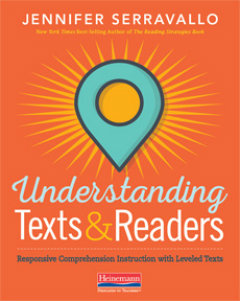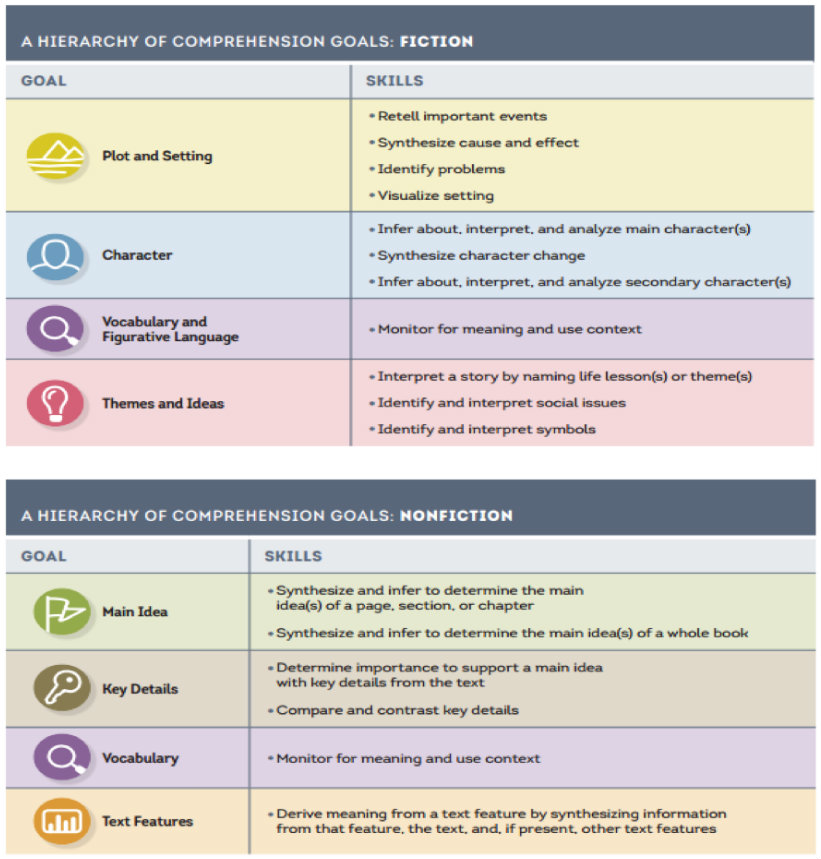Building Comprehension Using Leveled Texts
Understanding Texts & Readers: Responsive Comprehension Instruction with Leveled Texts
By Jennifer Serravallo
(Heinemann, 2018 – Learn more)

Simply amazing! Jennifer Serravallo outdid herself – again! Her new book, Understanding Texts & Readers: Responsive Comprehension Instruction with Leveled Texts, is one of the most teacher friendly books that I have read.
As a mentor and coach to student teachers, I am always looking for books that will help our next generation of professionals become more cognizant of their students’ literacy needs – and how to effectively meet those needs. In Serravallo’s book, you will learn more about:
- how to understand fiction and nonfiction texts,
- setting goals to aid the readers’ comprehension of increasingly more complex texts,
- how to assess and evaluate comprehension,
- criteria for matching readers with books for independent reading,
- conducting goal-setting conferences.

Comprehension is everything
Serravallo writes, “Understanding as you’re reading helps you to engage with the text, read the words accurately, read with fluency, understand what the author is saying, and think beyond the text. In essence, comprehension is everything.”
On my first reading of this, I was a bit shaken. What a responsibility for a teacher! Did I do my job adequately when I was in the classroom? How can I guide new teachers as they begin their teaching journey?
It is an awe-inspiring task, but with Serravallo’s help the goal isn’t insurmountable. Using the book as a guide, you will be able to scale the seemingly monumental challenge of finding the right books for your students and assisting them as they attempt to comprehend the text.
The good news: teachers will feel as if Serravallo is working side by side with them as she gives descriptions of texts ranging from levels J-W and her analysis of what teachers can expect at those levels. At each level, there are examples of the type of work that students should be doing as they think and write about reading.
Serravallo’s hierarchy of reading goals is there to give the teacher guidance along the way. It gives you a compete snapshot of what it means to comprehend a text and identifies goals for the students.
The book is broken into four parts:
Part 1: How the puzzling gap between one student’s running record and her comprehension of longer texts led Jen to new research and insight.
Part 2: Examples that demonstrate how fiction texts and student responses to them change as texts increase in complexity.
Part 3: Examples that demonstrate how nonfiction texts and student responses to them change as texts increase in complexity.
Part 4: How the knowledge you gain from assessments can be most effectively linked to strategies such as those in her best-selling Reading Strategies Book.
“You can’t level a reader.”
Her words rang loud, clear, and true to me but also had a tinge of sadness in them. How often are students identified by their reading ability? Ever hear a colleague identify their class as “I have mostly R readers” instead of saying, “I have a class of students who can’t wait to read independently.” Serravallo has generously provided a multitude of resources that teachers can use to generate a conversation about book choice.
She reminds us that student choice is not just about putting out the bin of “R” level books and asking students to choose from the bin. She points out there are many variables that influence student comprehension such as:
- A reader’s command of English
- The cultural relevance of the text
- The reader’s age and maturity level
- Memory, stamina, and attention
- The text genre
Right now you might be saying, “Are you telling me that leveling books is a waste of time?” She doesn’t advocate NOT to level books but to deeply reflect on HOW you are using the process. This book helps you know your readers, which in turn helps them grow as readers.
I am sure you are now thinking, “I am totally overwhelmed with lesson plans, assessments, and conferences. How am I ever going to even begin to start and how will I know if I am doing it correctly?”
I concur. I understand. Book leveling is not a perfect science. You can’t read every book in your classroom library. But once you become aware of the characteristics of each level, you will be better able to confer with your students about the skills and behaviors the reader needs to be able to tackle in their reading, such as the impact of secondary characters on the main character (Level R).
As I continued to read the book, I felt as if Jennifer Serravallo became a trusted mentor and that we were sitting at the kitchen table talking about the teaching of reading and how I could become more proficient at leveling books to inform my teaching.
I am in awe of the way she adds anecdotes and ties reading skills to relatable analogies. Her stories, examples, snippets from classrooms, and feedback are from years of research, consulting with other experts in the field, and from experts such as you – teachers in the classroom.
Student samples can inform your practice
One of the areas that I struggled with in the classroom was having a firm grasp of what student reading responses should look like. In the beginning, I expected their responses to be at least a page long. That was my mistake, and I apologize to my former students for that. If I had read a book such as this when I first started using Readers Workshop in the classroom, I would have been better informed about the characteristics of each reading level. I would have been better informed about how to look at student responses and how to guide them as readers to the next level.
I am especially appreciative of the book’s student samples included for each area, which are based on the increasing levels of texts. These examples are perfect conversation starters at a faculty or team meeting. Teachers are able to see how the level of student comprehension and sophistication in response changes with each level.
The final section of the book reminds me of a beautiful bow on a present. The fourth part explains how to put it all together and use it in the classroom: setting up a classroom library, assessment, getting to know your students. It answers the question: “Okay. Now what!?”
Read Jennifer Serravallo’s MiddleWeb article,
adapted from this book.
Read another review of this book.
Whenever you see that Jennifer Serravallo has written a book, you know it’s going to be a winner – a must for any literacy teacher or coach. This is a hefty book to read and absorb, a perfect book to read and discuss with colleagues. Organize a PLC (Professional Learning Community) and talk to your district about purchasing the books for your group. The rewards will be far reaching. A perfect addition for teachers’ resource library!
Now retired from teaching fourth graders, Linda Biondi is supervising preservice and student teachers at The College of New Jersey this fall. Over the summer she co-facilitated a weeklong writing institute in conjunction with the National Writing Project at Rider University. She volunteers for two service organizations: Homefront and Dress for Success of Central New Jersey – both have a mission to end poverty and homelessness. The mission of Dress for Success is to empower women to achieve through economic independence.




































